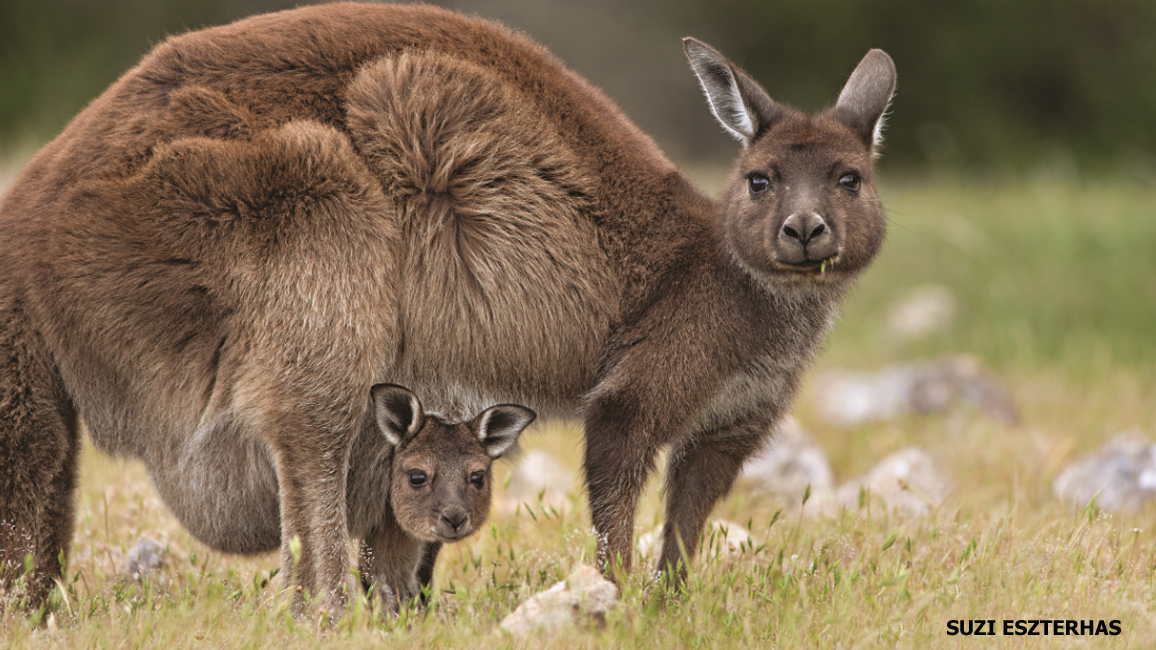
Life Down Under
By Anne Cissel; Photos by Suzi EszterhasWhat’s life like for a little “pouch potato”?

PEEK-A-BOO! The eight-month-old baby kangaroo, or joey, in the photo above looks pretty cozy in its mother’s pouch. These are western gray kangaroos, and millions of them live in Australia. They all start out the kangaroo way—tucked into their moms’ soft pockets of fur and skin. Animals that raise their young this way are called marsupials (mar-SOO-pee-ulz).
A joey stays hidden inside its mom’s pouch for months until it is ready to peek at the outside world. When it gets bigger, it’ll hop out for a little while to explore, always keeping mom close by. It won’t leave its mom’s pouch for good until it is nearly a year old. What would it be like to live aboard a mom that bounces here and there? Let’s find out!

KNOWN FOR NICKNAMES
Australians like to use funny words for things—kangaroos included! Most people call the animals roos as a nickname. A group is called a mob. People also call male western gray kangaroos stinkers. Why? Because of their strong smell.
FIGHT! FIGHT!
When stinkers fight over mates, they have boxing matches. They stand to their full heights, then punch and kick each other with powerful blows. Eventually, one gives up and hops away.
POUCH LIFE
A newborn joey is pink, hairless, blind—and the size of a grape! It may be small, but it has a great sense of smell and strong front legs and claws. As soon as it’s born, the tiny roo crawls up onto its mother’s belly and then into the pouch. There it finds a nipple and latches on.
The pouch makes a great home in many ways. As the joey grows, the pouch stretches wider and wider. But the mother can also clench the pouch tight, like pulling a drawstring bag closed. She might do this if she senses danger or to prevent the joey from falling out.
The lining of the pouch makes a special liquid that fights germs that might harm the baby. The mother also often licks the joey clean with her tongue.
At four months, the baby peeks out of the pouch. It might catch a nibble of grass when its mother leans down to graze. A few weeks later, it is ready to hop out and explore the outside world. But at the first hint of danger—such as hungry wild dogs—it will hop right back into the pouch.
A mother kangaroo can care for three youngsters at a time—an older joey that has left the pouch but still nurses, a young one growing inside the pouch, and another one still waiting to be born. She’s a supermom!
VIDEO: WATCH BABY KANGAROO’S FIRST DAY OUT!

LET’S GET HOPPIN’
Once the joey starts taking trips outside the pouch, it’s time to learn all the kangaroo moves. Most of the time, roos hop, using their enormous back legs as pogo sticks to push themselves forward. They use their tails for balance. Kangaroos belong to a group of animals called macropods, which means “big feet.”
Sometimes roos “walk,” using their front paws and tails for support as they lift their back feet forward. Scientists have discovered that the tail acts as a third leg when a kangaroo is walking—and has more strength than the front paws and back legs combined.
VIDEO: WATCH A KANGAROO USE ITS TAIL AS AN EXTRA LEG!
ALL TOGETHER NOW
Some kinds of kangaroos live alone, but western gray kangaroos like to live in mobs. A mob can have just a few members or up to 100. Western grays like to “talk” by touching noses or sniffing each other. They also grunt, cough, or hiss to communicate. A mother may make a clicking sound to call her young.
Even though these animals aren’t endangered, climate change is hurting kangaroos in Australia. In early 2020, wildfires destroyed a lot of forests and injured or killed many kangaroos and other animals. Climate change can cause extremely hot and dry weather, which was one of the reasons the fires were so bad. Working to fight climate change will help make sure all kangaroos keep hopping into the future.
















